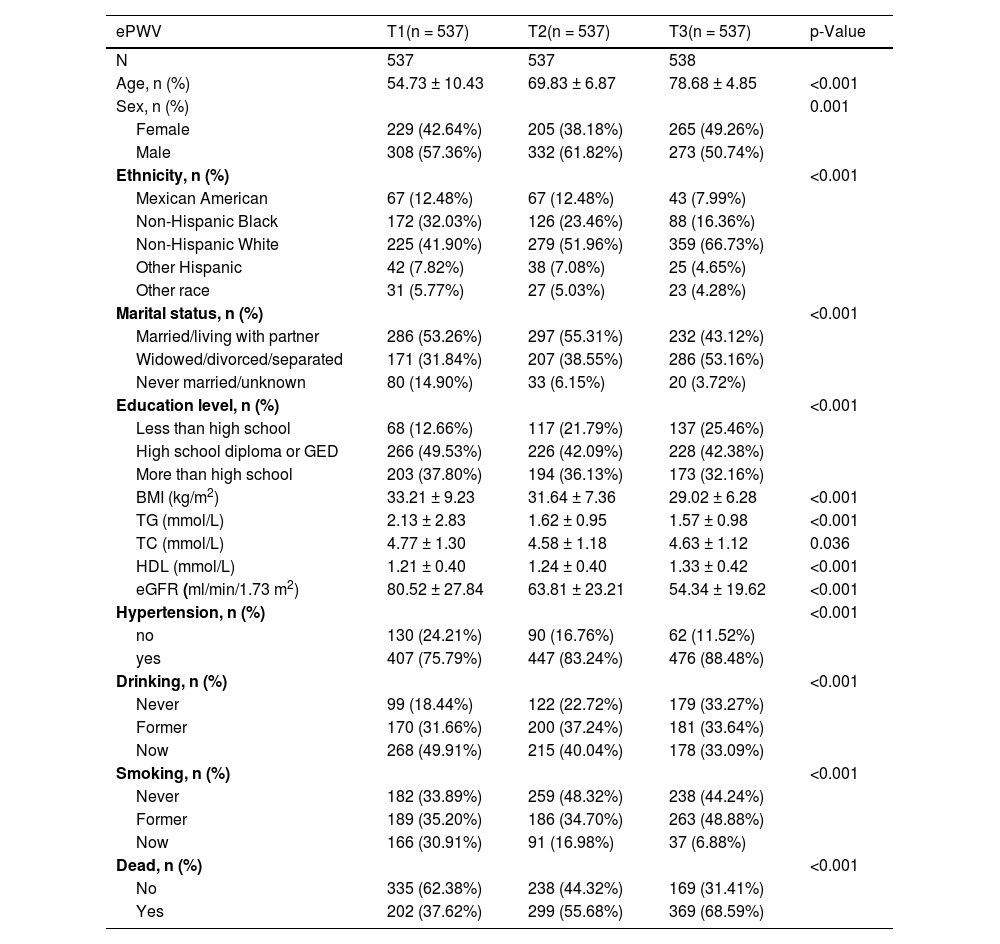Arteriosclerosis has been proven to be a risk factor for the development of heart failure and readmission. ePWV is a novel non-invasive and simple indicator of arterial stiffness, and this study aims to investigate its relationship with all-cause mortality rate in patients with heart failure.
MethodsThis study is a cohort study that included 1272 patients with heart failure from NHANES data from 1999 to 2018. The ePWV was divided into three groups, and the cumulative mortality rate of heart failure patients was calculated using KM survival curves. The relationship between ePWV and all-cause mortality rate in heart failure patients was represented by a smoothed curve fitting. COX regression analysis was used to assess the association between ePWV and all-cause mortality rate in heart failure patients.
ResultsThe average age of the study population was 67.8 ± 12.6 years, with 862 males and 650 females. During the 12-month follow-up period, there were 790 cases of all-cause mortality. Cox regression analysis was used to validate the relationship between ePWV and all-cause mortality rate in patients with heart failure. Patients with higher levels of ePWV tended to have a higher all-cause mortality rate. After adjustment for multiple factors, an increase in ePWV was positively associated with all-cause mortality rate (HR = 1.17, 95% confidence interval (CI): (1.12, 1.22)). Compared to the lowest tertile, the multivariable-adjusted HR and 95% CI for the highest tertile of ePWV were 1.81 (95% CI: (1.45, 2.27)). Additionally, a smoothed curve fitting was used to observe the relationship between ePWV and mortality rate, where the curve demonstrated a positive correlation between ePWV and all-cause mortality rate. Furthermore, KM survival curves indicated that all-cause mortality rate increased with the increase in ePWV. Subgroup analysis suggested a correlation between ePWV and mortality rate.
ConclusionOur study shows that ePWV is positively associated with all-cause mortality in patients with heart failure.
La arteriosclerosis ha demostrado ser un factor de riesgo para el desarrollo de insuficiencia cardíaca y readmisión. ePWV es un indicador novedoso, no invasivo y simple de la rigidez arterial, y este estudio tiene como objetivo investigar su relación con la tasa de mortalidad por todas las causas en pacientes con insuficiencia cardíaca.
MétodosEste estudio es un estudio de cohorte que incluyó a 1272 pacientes con insuficiencia cardíaca de los datos de NHANES de 1999 a 2018. El ePWV se dividió en tres grupos y se calculó la tasa de mortalidad acumulada de pacientes con insuficiencia cardíaca utilizando curvas de supervivencia de KM. La relación entre ePWV y la tasa de mortalidad por todas las causas en pacientes con insuficiencia cardíaca se representó mediante un ajuste de curva suavizado. Se utilizó análisis de regresión de COX para evaluar la asociación entre ePWV y la tasa de mortalidad por todas las causas en pacientes con insuficiencia cardíaca.
ResultadosLa edad promedio de la población del estudio fue de 67.8 ± 12.6 años, con 862 hombres y 650 mujeres. Durante el período de seguimiento de 12 meses, hubo 790 casos de mortalidad por todas las causas. Se utilizó un análisis de regresión de Cox para validar la relación entre ePWV y la tasa de mortalidad por todas las causas en pacientes con insuficiencia cardíaca. Los pacientes con niveles más altos de ePWV tendían a tener una tasa de mortalidad por todas las causas más alta. Después del ajuste de múltiples factores, un aumento en ePWV se asoció positivamente con la tasa de mortalidad por todas las causas (HR = 1.17, intervalo de confianza del 95% (IC): (1.12, 1.22)). En comparación con el tercil más bajo, la HR ajustada por múltiples variables y el IC del 95% para el tercil más alto de ePWV fueron 1.81 (IC del 95%: (1.45, 2.27)). Además, se utilizó un ajuste de curva suavizado para observar la relación entre ePWV y la tasa de mortalidad, donde la curva demostró una correlación positiva entre ePWV y la tasa de mortalidad por todas las causas. Además, las curvas de supervivencia de KM indicaron que la tasa de mortalidad por todas las causas aumentó con el aumento de ePWV. El análisis de subgrupos sugirió una correlación entre ePWV y la tasa de mortalidad.
ConclusiónNuestro estudio muestra que ePWV se asocia positivamente con la mortalidad por todas las causas en pacientes con insuficiencia cardíaca.
Article
Diríjase desde aquí a la web de la >>>FESEMI<<< e inicie sesión mediante el formulario que se encuentra en la barra superior, pulsando sobre el candado.

Una vez autentificado, en la misma web de FESEMI, en el menú superior, elija la opción deseada.

>>>FESEMI<<<











